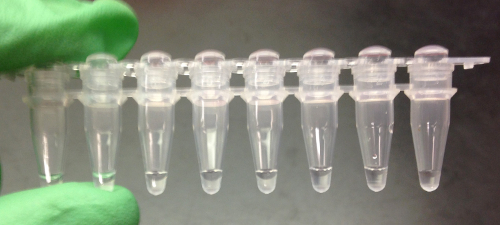RNA Analysis of Environmental Samples Using RT-PCR
Overview
Source: Laboratories of Dr. Ian Pepper and Dr. Charles Gerba - The University of Arizona
Demonstrating Author: Bradley Schmitz
Reverse transcription-polymerase chain reaction (RT-PCR) involves the same process as conventional PCR — cycling temperature to amplify nucleic acids. However, while conventional PCR only amplifies deoxyribonucleic acids (DNA), RT-PCR enables the amplification of ribonucleic acids (RNA) through the formation of complementary DNA (cDNA). This enables RNA-based organisms found within the environment to be analyzed utilizing methods and technologies that are designed for DNA.
Many viruses found in the environment use RNA as their genetic material. Several RNA-based viral pathogens, such as Norovirus, and indicator organisms, such as pepper mild mottle virus (PMMoV), do not have culture-based detection methods for quantification. In order to detect for the presence of these RNA viruses in environmental samples from soil, water, agriculture, etc., molecular assays rely on RT-PCR to convert RNA into DNA. Without RT-PCR, microbiologists would not be able to assay and research numerous RNA-based viruses that pose risks to human and environmental health.
RT-PCR can also be employed as a tool to measure microbial activity in the environment. Messenger RNA (mRNA) is the single-stranded template for protein translation, and measuring the levels of different mRNAs indicates which genes from which microbes are being expressed within the environment. Analyzing gene expression gives clues to what biological pathways are used by organisms to survive in different environmental conditions. In some cases, gene expression can be utilized to determine which organisms may survive best in harsh conditions and have capabilities for bioremediation of contaminated soil or water.
Procedure
1. Sample Collection: Soil Sample
- Find a sample location via GPS, coordinates, or sight.
- For random sampling, choose random points within an area to get a general census of microbial habitats. Transect sampling collects from points along a straight line, e.g., adjacent to a streambed. Grid samples are systematically taken from points at regular intervals, and are useful for mapping microbial communities in an unknown or variable area.
- Sampling within a 3-6 inch (7.5-15 cm) depth p
Results
When RT- PCR is complete, some of the PCR product can be separated and visualized on an agarose gel (Figure 3). In this example, a gene-specific primer was used to detect for the presence of an RNA virus. Bands of the expected size are obtained from two of the samples and the positive control reaction, but not from the negative control, indicating the presence of this virus in two of the water samples being tested.
Application and Summary
RT-PCR is necessary for creating cDNA from an RNA template. This enables RNA-based microorganisms to be analyzed utilizing molecular assays developed for DNA. Once the cDNA is synthesized, PCR assays can determine the presence or absence of RNA-based microorganisms within an environmental sample. This enables further downstream analysis to determine microbial ecology, health risks, and environmental risks.
RT-PCR can also be utilized to assay mRNA as a means to observe which genes are being expressed in an environment. This provides i
Tags
Skip to...
Videos from this collection:

Now Playing
RNA Analysis of Environmental Samples Using RT-PCR
Environmental Microbiology
40.4K Views

Determination of Moisture Content in Soil
Environmental Microbiology
359.7K Views

Aseptic Technique in Environmental Science
Environmental Microbiology
126.5K Views

Gram Staining of Bacteria from Environmental Sources
Environmental Microbiology
100.5K Views

Visualizing Soil Microorganisms via the Contact Slide Assay and Microscopy
Environmental Microbiology
42.4K Views

Filamentous Fungi
Environmental Microbiology
57.5K Views

Community DNA Extraction from Bacterial Colonies
Environmental Microbiology
28.9K Views

Detecting Environmental Microorganisms with the Polymerase Chain Reaction and Gel Electrophoresis
Environmental Microbiology
44.6K Views

Quantifying Environmental Microorganisms and Viruses Using qPCR
Environmental Microbiology
47.9K Views

Water Quality Analysis via Indicator Organisms
Environmental Microbiology
29.6K Views

Isolation of Fecal Bacteria from Water Samples by Filtration
Environmental Microbiology
39.4K Views

Detection of Bacteriophages in Environmental Samples
Environmental Microbiology
40.8K Views

Culturing and Enumerating Bacteria from Soil Samples
Environmental Microbiology
184.8K Views

Bacterial Growth Curve Analysis and its Environmental Applications
Environmental Microbiology
296.2K Views

Algae Enumeration via Culturable Methodology
Environmental Microbiology
13.8K Views
Copyright © 2025 MyJoVE Corporation. All rights reserved
